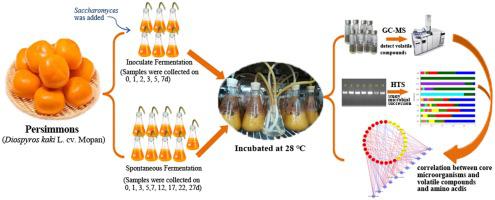当前位置:
X-MOL 学术
›
Process Biochem.
›
论文详情
Our official English website, www.x-mol.net, welcomes your feedback! (Note: you will need to create a separate account there.)
Comparative study of microbial communities and volatile profiles during the inoculated and spontaneous fermentation of persimmon wine
Process Biochemistry ( IF 4.4 ) Pub Date : 2021-01-01 , DOI: 10.1016/j.procbio.2020.09.023 Yao Lu , Xiaolei Guan , Rongbin Li , Jie Wang , Yaqiong Liu , Yanli Ma , Jiawei Lv , Suwen Wang , Jianlou Mu
Process Biochemistry ( IF 4.4 ) Pub Date : 2021-01-01 , DOI: 10.1016/j.procbio.2020.09.023 Yao Lu , Xiaolei Guan , Rongbin Li , Jie Wang , Yaqiong Liu , Yanli Ma , Jiawei Lv , Suwen Wang , Jianlou Mu

|
Abstract In this study, we determined the composition of microorganisms in the spontaneous/inoculated fermentation process of persimmon (Diospyros kaki L., China) wine for the first time and compared the similarities and differences of microbial succession, change in volatile compounds, and variations in amino acids. We found that spontaneous persimmon wine fermentation (SPF) resulted in lower bacterial community diversity and higher fungi community diversity than inoculated persimmon wine fermentation (IPF). SPF increased the proportion of esters in overall volatile compounds (29.9 % vs 18.9 %) at the end of fermentation. According to partial least squares (PLS, VIP > 1.0) analysis and Spearman’s correlation analysis, 18 (11 bacterial and 7 fungus) were identified as the functional core microbiotas in SPF. Among them, indigenous Saccharomyces, Hanseniaspora, Rhodotorula, Leuconostoc, and Lactobacillus play an important role in the formation of volatile compounds and are worthy of further study, while Escherichia-Shigella, Ralstonia and Zoogloea should be inhibited during the fermentation process. However, a key problem in SPF was the fermentation time, which was too long (about 27 days) and did not meet the needs of industrial production. Overall, the results showed the possibility of considering select indigenous aroma-producing microorganisms as persimmon wine fermentation starters to improve the unique characteristics of persimmon wine.
中文翻译:

柿酒接种与自发发酵过程中微生物群落及挥发分的比较研究
摘要 本研究首次测定了柿子酒自发/接种发酵过程中微生物的组成,比较了微生物演替、挥发性化合物变化和变异的异同。在氨基酸中。我们发现自发柿酒发酵 (SPF) 导致比接种柿酒发酵 (IPF) 更低的细菌群落多样性和更高的真菌群落多样性。在发酵结束时,SPF 增加了酯类在总体挥发性化合物中的比例(29.9% 对 18.9%)。根据偏最小二乘法 (PLS, VIP > 1.0) 分析和 Spearman 相关分析,18 种(11 种细菌和 7 种真菌)被确定为 SPF 中的功能核心微生物群。其中,本土酵母菌、Hanseniaspora、Rhodotorula、Leuconostoc和Lactobacillus在挥发性化合物的形成中起重要作用,值得进一步研究,而在发酵过程中应抑制Escherichia-Shigella、Ralstonia和Zoogloea。然而,SPF的一个关键问题是发酵时间太长(约27天),不能满足工业生产的需要。总体而言,结果表明可以考虑选择本地产香气微生物作为柿子酒发酵的发酵剂,以改善柿子酒的独特特性。在发酵过程中应抑制 Ralstonia 和 Zoogloea。然而,SPF的一个关键问题是发酵时间太长(约27天),不能满足工业生产的需要。总体而言,结果表明可以考虑选择本地产香气微生物作为柿子酒发酵的发酵剂,以改善柿子酒的独特特性。在发酵过程中应抑制 Ralstonia 和 Zoogloea。然而,SPF的一个关键问题是发酵时间太长(约27天),不能满足工业生产的需要。总体而言,结果表明可以考虑选择本地产香气微生物作为柿子酒发酵的发酵剂,以改善柿子酒的独特特性。
更新日期:2021-01-01
中文翻译:

柿酒接种与自发发酵过程中微生物群落及挥发分的比较研究
摘要 本研究首次测定了柿子酒自发/接种发酵过程中微生物的组成,比较了微生物演替、挥发性化合物变化和变异的异同。在氨基酸中。我们发现自发柿酒发酵 (SPF) 导致比接种柿酒发酵 (IPF) 更低的细菌群落多样性和更高的真菌群落多样性。在发酵结束时,SPF 增加了酯类在总体挥发性化合物中的比例(29.9% 对 18.9%)。根据偏最小二乘法 (PLS, VIP > 1.0) 分析和 Spearman 相关分析,18 种(11 种细菌和 7 种真菌)被确定为 SPF 中的功能核心微生物群。其中,本土酵母菌、Hanseniaspora、Rhodotorula、Leuconostoc和Lactobacillus在挥发性化合物的形成中起重要作用,值得进一步研究,而在发酵过程中应抑制Escherichia-Shigella、Ralstonia和Zoogloea。然而,SPF的一个关键问题是发酵时间太长(约27天),不能满足工业生产的需要。总体而言,结果表明可以考虑选择本地产香气微生物作为柿子酒发酵的发酵剂,以改善柿子酒的独特特性。在发酵过程中应抑制 Ralstonia 和 Zoogloea。然而,SPF的一个关键问题是发酵时间太长(约27天),不能满足工业生产的需要。总体而言,结果表明可以考虑选择本地产香气微生物作为柿子酒发酵的发酵剂,以改善柿子酒的独特特性。在发酵过程中应抑制 Ralstonia 和 Zoogloea。然而,SPF的一个关键问题是发酵时间太长(约27天),不能满足工业生产的需要。总体而言,结果表明可以考虑选择本地产香气微生物作为柿子酒发酵的发酵剂,以改善柿子酒的独特特性。


























 京公网安备 11010802027423号
京公网安备 11010802027423号